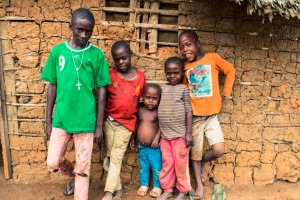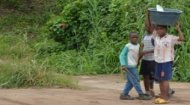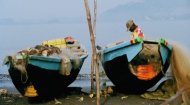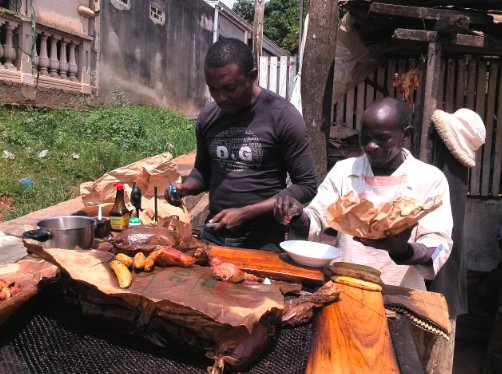|
|
|
Life in Cameroon |
Life in Cameroon |
Life in Cameroon | Life in Cameroon |
For information, videos and photos
about the African nation of
Cameroon, check out our profile pages.
More >
  |

|
Cameroon itself is located in western central Africa having 249 miles of coast on the Gulf of Guinea/Atlantic Ocean coastline known as the Bight of Biatra. It's further bordered by Nigeria to its west, Chad to its north-east, the Central African Republic to its east and Equatorial Guinea, Gabon and the Republic of the Congo to its south. Cameroon has an estimated 250 ethnic groups with over 200 languages, although French and English are the official languages reflecting the colonial history of the country. In the west and north-west of Cameroon, where the land mainly consists of plateaus, are tribes referred to as highlanders or grassfielders. The north itself is home to the Muslim Fulani (Fulani homestead below) whilst in the south are Bantu speaking tribes including the Fang, Duala, Basa and Bakas. Historically, after the defeat of the Germans in WWI, the area became effectively three areas; French Cameroun and the British Northern Cameroons and Southern Cameroons, which were administered separately.
Cameroon families live in traditional mud and thatch homes common across the Sahel although the use of tin and cement is becoming more common particularly in the south. Outside of urban areas, basic facilities like electricity are rare and in the north over half the population does not have access to proper medical facilities. The majority of these communities have a market place where on a daily, weekly or less often basis women sell their produce such as palm oil whilst men trade their livestock and bushmeat in a separate area. In the north of the country, every village has its own mosque, however modestly constructed. Life in Cameroon is dominated by men with both women and girls reduced pretty much to a role of servitude where violence against them is common place. Many girls are subjected to the practise of 'breast ironing'; an attempt to mutilate their breasts to prevent them developing in order to ward off advances by boys who associate the growth of breasts as a signal the girls are ready and available for intercourse. 70% of the population is involved in agriculture whilst 13% are involved in industries such as timber, tobacco, printing and the production of clay and glass items whilst the richest in Cameroon are involved in the over inflated and widely regarded as corrupt and inefficient service sector. Around 5000 are engaged in the fishing industry. Cameroon is in 151st place out of 191 countries and territories in 2021 when ranked in terms of life expectancy, literacy, access to knowledge and the living standards of a country with a life expectancy of 60.33 years (2021). The video (above) shows images of daily life in Cameroon and gives a good look and feel about what it's like living in the country. |





 At the time of independence, Northern Cameroons voted to be integrated into the newly independent Nigeria, whilst Southern Cameroons opted to be part of the newly emerging Republic of Cameroon. Today there is still a strong movement in the former Southern Cameroons to break away and form the independent Republic of Ambazonia. Indeed this was proclaimed in 1999 but has gained no recognition either within and outside of Cameroon.
At the time of independence, Northern Cameroons voted to be integrated into the newly independent Nigeria, whilst Southern Cameroons opted to be part of the newly emerging Republic of Cameroon. Today there is still a strong movement in the former Southern Cameroons to break away and form the independent Republic of Ambazonia. Indeed this was proclaimed in 1999 but has gained no recognition either within and outside of Cameroon.


